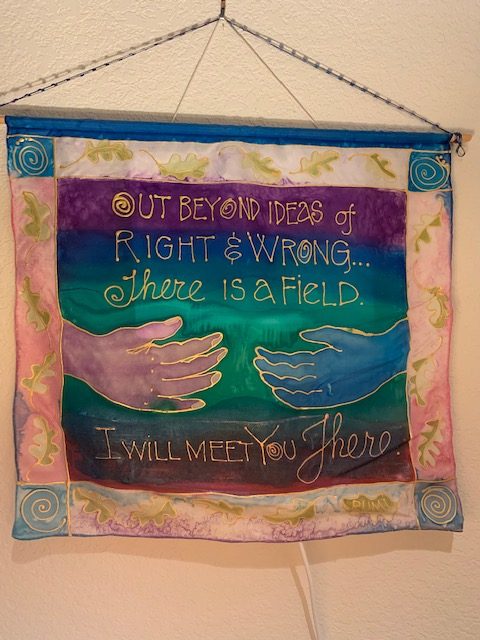Cohousing and the BLM Movement

Hanging on the wall in my house is a dyed silk-screen print done by an artist from the first cohousing community I worked with in California. On it is the simple quote by Rumi that says: “Out beyond the ideas of right and wrong there is a field. I will meet you there.” To me these simple words are the most powerful ones I have felt whenever when I try to think about human conflict and its challenges and cures.
As human animals we are programmed to naturally fear and suspect anyone or thing that is not familiar to us or is different from us whether it be a wild animal or another human that doesn’t look like us and our close associates. Most of us learn early in life ways to manage this fear to the best of our advantage, but as communal animals those ways generate herd and tribal instincts that result in prejudices against those different from us or our tribe.
We learn how to control our prejudices and fears through education, communication, and interaction with that which is different from us. In today’s modern world we are also learning that unless we can overcome our prejudices and differences and come together as a human race united in meaningful ways, we may well self-destruct life as we now experience it on the earth.
There are of course many ways that we do come together, some that are more toxic than others and breed fear, like leadership by dictators administered by police state. Others, establishing institutions for human cooperation and democratic governments are healthier for the human race. All ways are challenging especially when we try to confront our differences while trying to make any headway in human betterment and equity.
Looking through the cohousing lens, we should be evaluating all of our attempts to create housing equity based on the degree of neighbor to neighbor community that a given project or attempt at housing equity is generating. Connecting close neighbors to generate collaboration in the creation of safe, secure, diverse, and unbiased neighborhoods in ways that are, “a hand up and not a hand out” to those in need of decent housing should be a priority when allocating resources to help resolve housing challenges related to racial and other diversity issues.
Providing opportunities for people to be part of solutions that alleviate fear and prejudice should be a critical component of any affordable housing proposal. Co-ops and cohousing are community-based solutions that have potential to address diversity issues. To do so they need support in creating and perfecting their community building and diversity embracing aspects as well as their affordability.
We are proud of the positions our cohousing communities typically stand for on collaboration, inclusiveness, and thoughtful attention to diversity. However, there is much more community building work to be done before cohousing can or should claim a significant role in resolving human inequity. We know how to design and build good cohousing projects, but we still have a long way to go in learning and implementing exemplary communities that truly embrace diversity and human collaboration.
We self-appointed leaders of the cohousing movement are struggling in defining a role for cohousing to play in the current new awareness and awakening of human racial injustice and our American heritage around it, especially relative to housing and neighborhoods.
But what the cohousing movement needs now is action not just words. We need communities and projects that demonstrate real progress in breaking diversity barriers and creating interracial collaboration and are helping make amends for past biases’ and injustices.
Back in the days of yester-year, before Covid 19, the CohoUS Board had some discussion about how we might generate mutually beneficial collaboration with other non-profit groups to further our cause of “building a better world one neighborhood at a time”.
Now might be a good time to take that thought to a deeper level and begin discussions with other groups like Habitat for Humanity, HUD, The Urban Land Institute, and The National Co-operative Bank; organizations that may have the clout to leverage building sites, grants and below market financing, and have connections and support for innovative community based housing that people of color and others who have been disadvantaged would find attractive and be willing to collaborate with other like minded people in creating new models of cohousing. Who is ready to help take that idea on?
Category: Diversity
Tags: cohousing, Diversity, housing equity, Racial Equality
Views: 1833

